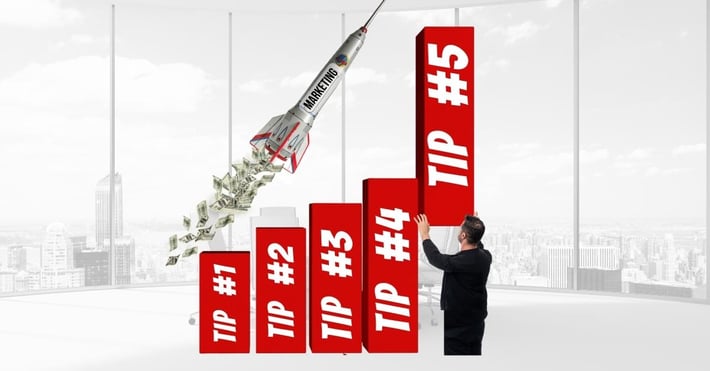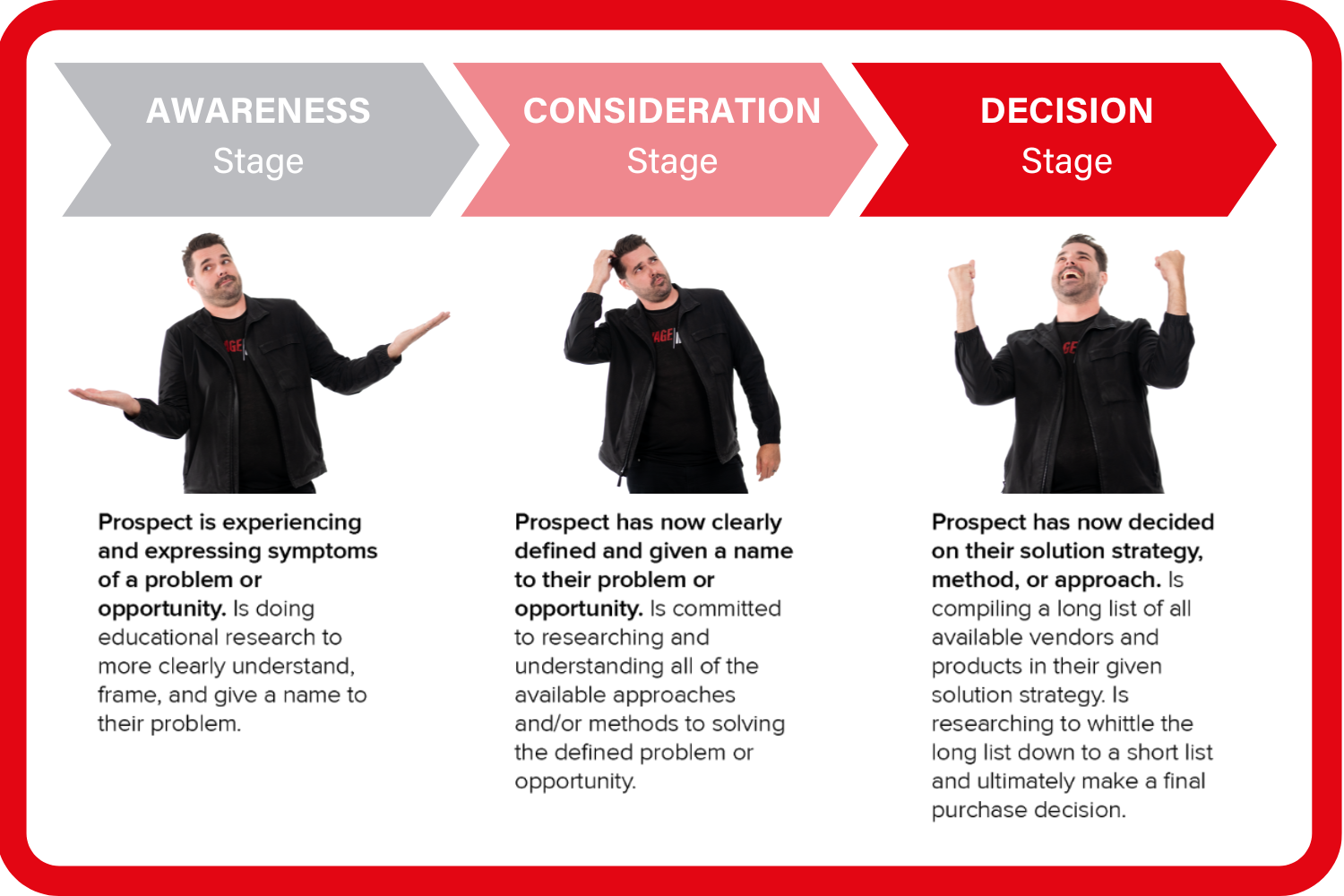From Numbers to Strategy: Maximizing Marketing Decisions through Effective Tracking
In the world of marketing, it has always been challenging to know which advertising efforts actually work. Famous American businessman John Wanamaker...
When it comes to allocating your marketing budget, the stakes are high. Every dollar spent needs to deliver tangible results and drive your business forward.

To help you navigate this challenge and make the most out of your marketing investment, we've gathered five expert tips from industry professionals.
By implementing these strategies, you can unlock the full potential of your marketing budget and propel your business towards success.
There is no magic bullet in marketing. You must create specific content and messaging that speaks to your prospect at their stage of the customer journey.
Understanding the customer journey is of paramount importance before investing money in marketing campaigns. By comprehending the different stages of the customer journey, including awareness, consideration, and decision-making, businesses can tailor their marketing efforts to effectively reach and engage their target audience. Let's delve into each stage to understand their significance:

Awareness Stage: The awareness stage marks the beginning of the customer journey. At this stage, potential customers may not be aware of your brand, products, or services. They may have a problem or a need but haven't identified your business as a solution yet. Investing in marketing activities that create brand awareness and capture the attention of your target market is crucial here. This can be achieved through various channels such as content marketing, social media advertising, search engine optimization (SEO), and display advertising. By understanding the awareness stage, businesses can develop strategies to increase brand visibility and attract potential customers.
Educational Blog Posts: Create informative and educational blog posts that address common pain points, challenges, or questions that your target audience may have. Offer valuable insights and tips related to your industry or niche.
Infographics: Visual content like infographics can effectively convey complex information in a visually appealing and easy-to-understand format. Use infographics to present statistics, industry trends, or comparisons that highlight the value of your product or service.
Explainer Videos: Create short videos that explain the benefits and features of your product or service. Use storytelling techniques to captivate your audience and showcase how your solution can solve their problems or meet their needs.
Social Media Posts: Share engaging and informative posts on social media platforms to spark curiosity and generate awareness. Use compelling visuals, catchy headlines, and brief snippets of information to capture attention and encourage users to learn more.
eBooks or Whitepapers: Develop in-depth resources like eBooks or whitepapers that delve into industry trends, best practices, or comprehensive guides. Offer these resources as free downloads in exchange for contact information, allowing you to nurture leads.
Consideration Stage: Once customers become aware of your brand, they move into the consideration stage. Here, they actively research and evaluate different options to address their needs. Understanding this stage allows businesses to provide the right information and resources to help customers make informed decisions. Content marketing plays a significant role during this stage, as businesses should focus on creating valuable content that educates and positions their brand as a reliable solution. This can include blog posts, whitepapers, case studies, videos, and comparison guides. Additionally, remarketing techniques, such as targeted ads and email campaigns, can reinforce the brand's value proposition and keep it top of mind.
Marketing Content Examples for Consideration StageCase Studies: Showcase real-life examples of how your product or service has successfully solved problems or delivered results for previous customers. Use case studies to highlight specific challenges, solutions implemented, and measurable outcomes achieved.
Decision Stage: In the decision stage, customers are ready to make a purchase or commit to a specific solution. They have narrowed down their options and are looking for reasons to choose your brand over competitors. It is crucial to understand the decision-making factors that influence customers at this stage. This includes highlighting unique selling points, offering compelling incentives, showcasing positive reviews and testimonials, and providing a seamless purchasing experience. Leveraging social proof, such as customer success stories or influencer endorsements, can also help build trust and credibility. By understanding the decision stage, businesses can optimize their marketing efforts to drive conversions and turn prospects into loyal customers.
Marketing Content Examples for Decision Stage
Product Comparison Charts: Create side-by-side product comparison charts that highlight the key features, pricing, and benefits of your offering compared to competitors. Make it easy for prospects to see how your product stands out and meets their specific requirements.
Free Consultations or Demos: Offer free consultations or personalized demos to prospects who are ready to make a decision. Provide hands-on guidance and showcase how your product or service can specifically address their unique needs.
Customer Success Stories: Share success stories and testimonials from satisfied customers who have achieved significant results with your product or service. Highlight the specific outcomes and benefits they experienced, emphasizing how your offering can deliver similar results.
Limited-Time Offers or Discounts: Create exclusive, time-sensitive offers or discounts to incentivize prospects to make a decision. Limited-time promotions can create a sense of urgency and encourage prospects to take action.
Implementation Guides: Provide detailed implementation guides or step-by-step tutorials that walk prospects through the process of using your product or service. Show them how to get started and make the most out of their purchase, addressing any potential concerns or obstacles.
Money-Back Guarantees or Risk-Free Trials: Offer a money-back guarantee or risk-free trial period to alleviate any concerns prospects may have about making a final decision. This gives them the confidence to try your offering without the fear of wasting their investment.
Client Testimonials and Reviews: Continue to showcase client testimonials and reviews that specifically highlight the positive experiences and outcomes of those who have chosen your product or service. Provide social proof to reinforce the decision-making process.
By gaining a comprehensive understanding of the customer journey and its various stages, your businesses can align its marketing strategies and investments accordingly. This allows your company to reach the right audience with the right message at the right time, maximizing the effectiveness of their marketing campaigns.
Investing in customer journey mapping, analytics, and continuous evaluation of customer feedback can further enhance the understanding of each stage and drive continuous improvement in marketing efforts. Ultimately, this understanding enables businesses to build stronger customer relationships, increase conversions, and drive long-term success.
To ensure your marketing budget is utilized efficiently, establish Specific, Measurable, Attainable, Relevant, and Time-bound (SMART) goals for each campaign and initiative. SMART goals provide a clear roadmap, allowing you to track progress and measure success accurately.
For example, a SMART goal could be to increase website traffic by 20% within the next three months by implementing a targeted SEO strategy, optimizing social media campaigns, and launching a content marketing campaign to attract and engage the target audience.
By aligning your marketing efforts with SMART goals, you can make data-driven decisions, optimize your strategies, and allocate your budget based on performance and desired outcomes.
Creating unique and valuable content is undoubtedly a resource-intensive endeavor. To maximize the value of your marketing budget, embrace the power of content repurposing and updating. Start by producing evergreen content that retains its relevance over time.
Then, repurpose and promote this content across multiple formats and channels. Furthermore, revisit and update previously published evergreen assets to provide up-to-date information to your audience and improve their search engine rankings.
This strategic approach allows you to extract maximum value from your marketing budget by re-promoting assets multiple times throughout the year.
To optimize your marketing budget allocation, regularly evaluate your campaigns and identify underperforming channels. By focusing your resources on the channels that generate the most revenue and phasing out campaigns that fail to deliver a return on investment, you can allocate your budget more effectively.
However, if data suggests potential for improvement, use underperforming channels for experimentation while following the 70-20-10 rule. Allocate 70% of your marketing budget to proven strategies, 20% to new strategies, and 10% to experimental approaches, which can uncover opportunities for future growth.
At Savage Media we suggest evaluating your campaigns at least every month or biweekly if possible. This will allow you to identify unnecessary spending, reallocate resources to high-performing campaigns, and make informed decisions about variable costs like ad spend
Managing multiple marketing projects can be a complex and overwhelming task, especially for businesses with limited resources and expertise. That's where the option of partnering with a marketing agency comes into play. When your budget allows, enlisting the help of a marketing agency can be a game-changer for your business.
A marketing agency serves as an extension of your team, bringing specialized expertise, industry knowledge, and a fresh perspective to the table. These agencies are well-versed in the ever-evolving landscape of marketing strategies, tactics, and technologies. They stay up-to-date with the latest trends, consumer behaviors, and best practices, ensuring that your marketing efforts remain relevant and effective.
One of the primary benefits of working with a marketing agency is their ability to streamline processes and optimize your marketing activities. They have refined workflows, tools, and systems in place to manage campaigns efficiently.
By leveraging their experience and established methodologies, agencies can save you valuable time and resources, allowing you to focus on other crucial aspects of your business.
Furthermore, marketing agencies have a diverse team of professionals with different skill sets. From graphic designers and copywriters to SEO specialists and social media experts, they bring a collective pool of talent to tackle various aspects of your marketing initiatives.
This ensures that you have access to the right skill sets required for each specific project, eliminating the need to hire and manage individual specialists in-house.
While hiring a marketing agency comes at a cost, it's important to view it as an investment rather than an expense. By partnering with an agency, you gain access to their expertise, knowledge, and industry connections, which can help you achieve better results in a shorter timeframe.
They have the resources to implement data-driven strategies, conduct market research, and analyze campaign performance, allowing you to make informed decisions and allocate your marketing budget more effectively.
Moreover, working with a marketing agency provides a level of objectivity and fresh perspectives that can be invaluable to your business. They bring an outsider's viewpoint and can offer insights and ideas that you may not have considered before. This external perspective can help you break through stagnant patterns, discover new opportunities, and differentiate your brand from the competition.
In conclusion, mastering the art of maximizing your marketing budget is a crucial step towards achieving remarkable success in today's competitive business landscape. By implementing these five expert tips, you can unlock the full potential of your marketing investment and propel your business towards new heights.
Remember, every dollar invested in your marketing efforts should be a strategic step towards achieving your goals, connecting with your target audience, and fostering lasting customer relationships.
By unlocking the full potential of your marketing budget, you position your business on a trajectory of continuous growth, impact, and prosperity.

In the world of marketing, it has always been challenging to know which advertising efforts actually work. Famous American businessman John Wanamaker...

In the ever-changing landscape of B2B marketing, staying ahead of the curve is vital for success. As businesses adapt to shifting market dynamics,...

Ask any successful marketer and they’ll tell you that content marketing is essential to creating a marketing strategy in 2022.